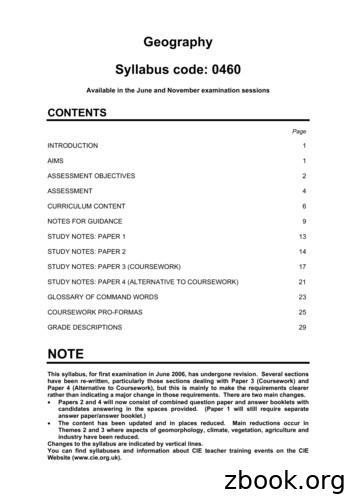IGCSE 0460/42 Geography Paper 4 May/June 2020
Cambridge IGCSE * 8 1 7 7 0 5 5 3 8 0 *GEOGRAPHY0460/42May/June 2020Paper 4 Alternative to Coursework1 hour 30 minutesYou must answer on the question paper.You will need:Insert (enclosed)CalculatorProtractorRulerINSTRUCTIONS Answer all questions. Use a black or dark blue pen. You may use an HB pencil for any diagrams or graphs. Write your name, centre number and candidate number in the boxes at the top of the page. Write your answer to each question in the space provided. Do not use an erasable pen or correction fluid. Do not write on any bar codes. If additional space is needed, you should use the lined pages at the end of this booklet; the questionnumber or numbers must be clearly shown.INFORMATION The total mark for this paper is 60. The number of marks for each question or part question is shown in brackets [ ]. The insert contains additional resources referred to in the questions.This document has 16 pages. Blank pages are indicated.DC (KN/CGW) 180463/6 UCLES 2020[Turn over
21Charity workers were doing research into differences in the health of families in Chennai, a cityin India. They worked in two densely populated areas of the city which are both shown in Fig. 1.1(Insert). One was an area of unplanned housing (squatter settlement) and the other was anotherarea of poor quality housing which was planned and permanent.The researchers wanted to find out if the following hypotheses were correct:Hypothesis 1: Diseases were more common in the area of unplanned housing than in thearea of permanent housing.Hypothesis 2: Most residents in both areas used government health facilities.(a) To investigate the two hypotheses the researchers used a questionnaire with a representativesample of people who lived in each area. The sample size (number of people who answeredthe questionnaire) was 100 in each area.(i)Why did the researchers need to use a sample of people?. [1](ii)Information which is collected using a questionnaire is known as ‘primary data’. Whatdoes ‘primary data’ mean?. [1](iii)The following is a poor sampling method which may have been used to get arepresentative sample of people to answer the questionnaire.‘Give the questionnaire to all mothers who the researchers met outside the local school.’Explain why this is a poor method to obtain a representative sample. [3] UCLES 20200460/42/M/J/20
3(iv)Describe a good sampling method which the researchers could use to choose arepresentative sample of people to answer the questionnaire. Explain why this would bea good method to use. [3] UCLES 20200460/42/M/J/20[Turn over
4(b) The questionnaire is shown in Fig. 1.2 (Insert). The results of Question 1 in the questionnaireare shown in Table 1.1 (Insert).(i)Plot the results for typhoid in the unplanned housing area in Fig. 1.3 below.[1]Illnesses suffered by family members10090807060number of50people403020100CholeraDiabetesDiarrhoea Respiratory Tuberculosis Typhoiddisease(TB)type of illnessKeyunplanned housing areapermanent housing areaFig. 1.3(ii)What conclusion would the researchers make about Hypothesis 1: Diseases were morecommon in the area of unplanned housing than in the area of permanent housing? Whatevidence in Fig. 1.3 and Table 1.1 supports their conclusion?. [4] UCLES 20200460/42/M/J/20
5(c) The results of Question 2 in the questionnaire are shown in Table 1.2 (Insert).(i)Use the results to complete the pie graph for the permanent housing area in Fig. 1.4below.[2]Where people go for treatment of an illnessUnplanned housing area0%90108020703060Key40Family or friends50Clinic or hospital run by a charity or NGOPermanent housing areaGovernment doctor, clinic or hospital0%90Private doctor, clinic or hospital1080207030604050Fig. 1.4 UCLES 20200460/42/M/J/20[Turn over
6(ii)The researchers agreed a conclusion that Hypothesis 2: Most residents in both areasused government health facilities was incorrect. Support this decision with evidencefrom Fig. 1.4 and Table 1.2. [3](d) (i)The results which the researchers obtained for Question 2 were unexpected. One ofthe researchers suggested that they should have used the questionnaire in a pilot studybefore doing the main research. How might this have helped?. [2] UCLES 20200460/42/M/J/20
7(ii)The researchers returned to the two areas of the city and asked people to answer anotherquestion: ‘What is the main reason you chose not to use government health facilities?’The answers which people gave are shown in Table 1.3 (Insert).Complete the graph, Fig. 1.5 (below), to show the answers given by people in theunplanned housing area.[2]The main reason people chose not to use the government health facilitiesUnplanned housing area0%20%40%60%80%100%80%100%KeyPoor quality of treatmentLong waiting times to be treatedLong distance to travelLimited and inconvenient opening hoursLack of qualified medical staffPermanent housing area0%20%40%60%Fig. 1.5(e) Suggest how the health of residents in poorer areas of the city could be improved. [4] UCLES 20200460/42/M/J/20[Turn over
8(f)The researchers wanted to extend their study by investigating housing conditions in the twoareas. Describe how they could collect information about housing conditions. Do not includea questionnaire in your answer. [4][Total: 30] UCLES 20200460/42/M/J/20
92Students were planning fieldwork on a local pebble beach. The students wanted to investigatehow pebbles varied in size. The beach, which is divided into sections by groynes, is shown inFig. 2.1 (Insert).(a) Fig. 2.2 (Insert) shows one of the groynes. Describe the groyne. [2](b) When the students arrived at the beach they saw a safety notice which is shown inFig. 2.3 (Insert). Suggest four instructions their teacher would give the students to keepthem safe whilst they did measurements at the sites shown in Fig. 2.4 (Insert).1 .2 .3 .4 . [4] UCLES 20200460/42/M/J/20[Turn over
10Groups of students worked in the different sections of the beach to investigate the followinghypotheses:Hypothesis 1: The pebbles get smaller from the cliff towards the sea.Hypothesis 2: The pebbles get smaller from south to north in the section of the beach betweentwo groynes.(c) The students collected 20 pebbles at each of nine sites shown in Fig. 2.4 (Insert). They thenmeasured the length, width and depth of each pebble. An example of this measurement isshown in Fig. 2.5 (Insert).(i)Fig. 2.6 (below) shows the actual size of one of the pebbles collected. Complete theActual insizeonebelow.pebblemeasurements of this pebbletheoftable[2]Actual size of one pebblelengthdepthlengthwidth widthdepthFig. 2.6(ii) UCLES 2020012340123length45675670 mm7width. mmdepth. mmcmcm88In the space below calculate the average of the three measurements.0460/42/M/J/20[1]
11(d) The results of the students’ measurements at site M2 (on Fig. 2.4) are shown in Fig. 2.7below.(i)The average of the three measurements of pebble number 13 is 53 mm. Plot thismeasurement in Fig. 2.7.[1]pebble numberStudents’ results at site 0average of the three measurements (mm)Fig. 2.7(ii)Which pebble at site M2 has the largest average of the three measurements?.(e) (i)[1]The results of the students’ measurements for the nine sites are shown in Fig. 2.4(Insert).Do these results support Hypothesis 1: The pebbles get smaller from the cliff towardsthe sea? Support your decision with evidence from Fig. 2.4. [3] UCLES 20200460/42/M/J/20[Turn over
12(ii)Explain why the size of pebbles varies in the area between the sea and the cliff. [3](f)(i)Look again at Fig. 2.4 (Insert). Which one of the following is the correct conclusion toHypothesis 2: The pebbles get smaller from south to north in the section of the beachbetween two groynes? Tick (3) your decision in the box below.Tick (3)The conclusion is true for sites U1, U2 and U3The conclusion is true for sites M1, M2 and M3The conclusion is true for sites L1, L2 and L3[1](ii)Use data from Fig. 2.4 to support the conclusion you have chosen. [1](iii)Use data from Fig. 2.4 to show why one of the conclusions you rejected is wrong. [1](g) Movement of pebbles along a beach, which was tested in Hypothesis 2, is influenced bylongshore drift. The students had learned that longshore drift is usually affected by theprevailing wind direction.(i)How could the students have checked the wind direction when they did their fieldwork?. [2] UCLES 20200460/42/M/J/20
13(
5 UCLES 2020 0460/42/M/J/20 [Turn over (c) The results of Question 2 in the questionnaire are shown in Table 1.2 (Insert). (i) Use the results to complete the pie graph for the permanent housing area in Fig. 1.4 below. [2] Where people go for treatment of an illness % 0 10 20 30 40 50 60 70 80 90 % 0 10 20 30 40 50
IGCSE First Language English 12 IGCSE World Literature 13 IGCSE English as a Second Language 14 . IGCSE Business Studies 19 IGCSE Global Perspectives 21 IGCSE Geography 22 IGCSE History 23 IGCSE Sciences 24 IGCSE Cambridge Mathematics Extended & Core 26 . At BISP, Year 12 and 13 (Key Stage Five) students study the IB Diploma Programme (IBDP .
complete until we have received your payment. Please avoid paying on last day of normal stage . IGCSE CAMBRIDGE INTERNATIONAL EXAMINATIONS MAY/JUNE 2021 IGCSE FEES IN NAIRA . IGCSE GEOGRAPHY 0460 AY 57,255.00 88,529.00 133,730.00 IGCSE GEOGRAPHY 0460 BY 58,142.00 89,416.00 134,617.00 IGCSE GEOG
IGCSE ARABIC for Native Arabic Speakers - Edexcel 11 GCSE ART & DESIGN - Edexcel 13 IGCSE BUSINESS STUDIES - Cambridge 15 IGCSE ECONOMICS - Cambridge 17 IGCSE COMPUTER SCIENCE - Cambridge 19 GCSE DRAMA - Edexcel 20 IGCSE ENGLISH LANGUAGE - Cambridge 22 IGCSE ENGLISH LITERATURE - Edexcel 22 IGCSE GEOGRAPHY - Edexcel 25
GEOGRAPHY 0460 IGCSE (2006) 1 INTRODUCTION International General Certificate of Secondary Education (IGCSE) syllabuses are designed as two-year courses for examination at age 16-plus. This syllabus is available for examination in both the June and November sessions. All IGCSE syllabu
Cambridge IGCSE Geography 0460 3 How to use this guide The guide describes what you need to know about your Cambridge IGCSE Geography examination. It will help you to plan your revision programme and will explain what we are looking for. Not all the information will be relevant to you. You
Upcoming Cambridge IGCSE training in Rome 05-06 April 2017 Introductory Cambridge IGCSE English as a Second Language (0510) Introductory Cambridge IGCSE International Mathematics (0607) Introductory Cambridge IGCSE Art and Design (0400) Extension Cambridge IGCSE Geography (0460) 07-08 April 2017
Revision Checklist for IGCSE Geography 0460 A Guide for Students . This Paper will be in a booklet with spaces to write your answers. IGCSE Geography 0460 Revision Checklist . . and decision making Being able to make judgements based on information and recognise possible
GEOGRAPHY 0460/21 Paper 2 Geographical Skills May/June 2020 1 hour 30 minutes You must answer on the question paper. You will need: Insert (enclosed) Plain paper 1:50 000 survey map (enclosed) Protractor Calculator Ruler INSTRUCTIONS Answer all questions. Use a black or dark blue pen. You may use an HB pencil for any diagrams or graphs.























